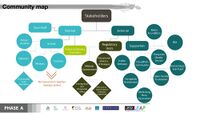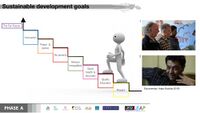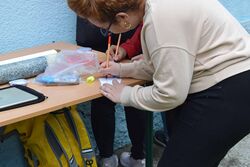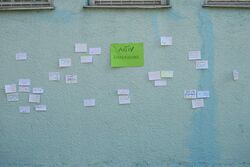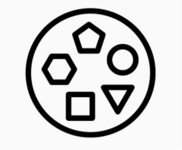LED2LEAP 2021 - Budapest Team: Difference between revisions
Kinga.furton (talk | contribs) |
|||
| Line 66: | Line 66: | ||
== Relationships Between Your Actors and Groups == | == Relationships Between Your Actors and Groups == | ||
The internal social group is the most affected by the landscape challenge, especially students from the Roma community. This group has the least influence. | |||
On the other hand, you can see the clear opposite of this. Those who are not impacted by the landscape challenges are the ones to make the rules and have the most power. These are the external stakeholders. | |||
As they are involved in the school, the internal stakeholders have a high impact due to this. The school, dorm staff, and supporters have a shared interest. They want the Roma community to integrate, get adequate schooling, and for this place to be safe and comfortable. They want to demolish the cultural differences. | |||
Finally, the Miskolc community is not so impacted by challenges especially the commuters. They also have low power. | |||
<gallery caption=" " widths="200px" heights="150px" perrow="5"> | <gallery caption=" " widths="200px" heights="150px" perrow="5"> | ||
Revision as of 11:06, 15 June 2021
>>>back to working groups overview
For help with editing this Wiki page use this link.
For assignments and key readings use this link.
Landscape Democracy Rationale
- Dr. Ambedkar School is a Buddhist school with a focus on working with the Roma community. The school is located in the city of Miskolc, the city is known as an industrial town and has a very diverse townscape with many industries and housing estates, but it is mostly residential in the School surroundings. Also known as the second chance school, it is a secondary school where the students are encouraged to improve their quality of life through better education, to be able to reach the formal job market, and have a stable job with a fair wage.
- The school was moved to its location in Miskolcs in 2019 before it was located in a Roma settlement called Sájokaza to the north of Miskolc. The Roma community faces many landscape and social challenges in their settlements due to their very poor conditions. One of the main challenges is the segregation from the Roma community to the Hungarian community. Being usually placed in enclosed housing blocks or distant settlements, where the health conditions, education, and job opportunities are very poor.
- Besides keeping the students engaged, the challenges the school faces include the contrast in the landscape between the Roma settlements and the City of Miskolc, and also the school structure which is not adapted to be a school and lacks leisure areas.
Location and Scope
- Location of Dr. Ambedkar School.
The school is located in Miskolc, in the Northern region of Hungary. This is one of the poorest regions in the country, and many Roma settlements are located here. Although the city of Miskolc is the 4th biggest in Hungary, the Roma settlements around it are small, mostly ruined in structure and their residents are very poor.
Phase A: Mapping Your Community
Welcome to Your Community and Their Landscape
- The Roma community from Miskolc's surroundings and the Dr. Ambedkar School
Groups of Actors and Stakeholders in Your Community
- Relationships of Miskolc's community and the School's Community
Relationships Between Your Actors and Groups
The internal social group is the most affected by the landscape challenge, especially students from the Roma community. This group has the least influence. On the other hand, you can see the clear opposite of this. Those who are not impacted by the landscape challenges are the ones to make the rules and have the most power. These are the external stakeholders. As they are involved in the school, the internal stakeholders have a high impact due to this. The school, dorm staff, and supporters have a shared interest. They want the Roma community to integrate, get adequate schooling, and for this place to be safe and comfortable. They want to demolish the cultural differences. Finally, the Miskolc community is not so impacted by challenges especially the commuters. They also have low power.
Summary of Your Learnings from the Transnational Discussion Panel
In this community, we are facing a lot of challenges first of all with a basic one: The Right to Landscape. There is a question here, what kind of a landscape is that, that this community has a right, has access to. Because of the poverty reigning in that area, there is little chance for development. So if we look at the landscape as a cultural realm two out of three points cannot be even taken into consideration here. Spiritual wellbeing is the only angle that we can approach the landscape because the Roma community has a really strong cultural heritage. If we take a look at this community of the democracy site, the situation is almost the same. Forinstance the Arnstein (1969) Ladder. In more developed countries, communities, they are a higher up. The Miskolc community is currently at the so-called „no power” stage, at the bottom, probably the manipulation is accurate. As summarised there, are so many „wicked” problems, which are very hard to solve. The main issue is that the Roma people is not being heard or represented.
Theory Reflection
The Roma community in Miskolc has a lot to develop, that is why there is no clear answer yet to what are the most important goals. The Dr. Ámbédkar School is offering youngsters the education they cannot get in a normal government school. We can translate this as a sustainable development goal, the quality education. It is still in progress but heading in the right direction. The order of the other goals is unclear. In general, the most important goals are good health and structure, reduce inequality, no poverty. In the documentary „Angry Buddha” (2016) the current principal of the school said: „In 200 years. This is not a joke. In 200 years.” That is when the situation for the gypsy people will change. As we were working during the pandemia, we faced a couple of challenges, for example, all the work was done online, we had little chance to visit the site, this way the most important thing was missing, we could not meet with the people, could not feel the place. In conclusion, the work, just as the long process, is very instructive, shocking, hard, but also funny.
References
- Ludwig, S. (Director). (2016). Angry Buddha [Documentary film].
- http://www.ambedkar.hu/
- https://www.hellomiskolc.hu/
- https://www.ksh.hu/regionalatlas_regions
- Shelley Egoz, Jala Makhzoumi and Gloria Pungetti (2011): The Right to Landscape: An Introduction
- Arnstein, Sherry R.(1969): A Ladder of Citizen Participation
Phase B: Democratic Landscape Analysis and Assessment
Tayana Passos Rosa and Angkita Hawlader Correspondence
Angkita and I exchanged some emails regarding the readings. It was a pity that, because I couldn't reply during a period, I lost the opportunity to continue exchanging emails with her for this Assignment. Some communication problems occurred and I couldn't be assigned to another partner. But even though the exchange with Angkita was short, it was fruitful and I'll share here some of it and then some thoughts of my own.
Highlighting here, I'll add some of my thoughts related to the reading and our Living Lab in Budapest.
My overall reflection from the readings is that if you want to design for a community you need to first truly understand it. All knowledge is valuable, from the community experience in their everyday life, their culture, until the most specialized scientific knowledge from the professionals assigned to work in the area. And this exchange is beneficial to all because everyone learns something during this process, and every opinion weights the same. My favorite quote from all the readings is: "design with empathy rather than sympathy" (de la Pena et al. p. 10). I think this fits so well in our Budapest Living Lab situation. We are working with Dr. Ambedkar School, a Buddhist school mostly for the Roma community in Northern Hungary. The community faces a low education rate, poverty, lack of career opportunities, among many other challenges, all caused by segregation and prejudice. The school methodology tries to give the students another light on possibilities for the future through studies. I think the second chapter from de la Peña has very valuable tools to try and apply in this project, to go beyond the research of the community in a virtual environment, but also visit them in real life, experience their landscape, but especially see through their eyes and try and combine all our pieces of knowledge to achieve the best solution possible.
Linus and Max Correspondence
Your Name and Partner's Name Correspondence
- ''insert text here''
Your Name and Partner's Name Correspondence
- ''insert text here''
Your Name and Partner's Name Correspondence
- ''insert text here''
Phase C: Collaborative Visioning and Goal Setting
The Scene in Your Story of Visioning
The workshop took place at Dr. Ámbédkar School in Miskolc on May 31st. During the workshop the students selected one landscape democracy challenge out of six. They decided on: Active Schoolyard. Their idea is to make the most out of the schoolyard so more people can use it for many different things at every season of the year. The students said they want to do activities such as gardening, different types of sports, studying, reading and just chatting and relaxing with each other.
The Actors in Your Story of Visioning
Since the schoolyard is used by the students of the school they came up with several ideas for their vision with the help of the teachers, university students and kultúrAktív associates present there.
The Story of Visioning
Story-Telling 1:
How we developed goals together and how we managed to prioritize them
- Choosing Challenge
At the beginning of the workshop we started with choosing the challenge. We had 6 prepared Challenges that Anita described to them. A lot of them were also overlapping. The different challenges were laid on the floor and then the students could choose which they were most interested in on discussing or most passionate about. In the first round it was still spread and we removed the first three (two with no votes one with just one vote) and did another round and so on until it was just one challenge left. The challenge they decided for was the Active Schoolyard
- Sharing Personal Goals
In the next steps the students could write down two personal goals they had for this challenge. They briefly shared them with the group and explained them and we clustered it on the wall.
- Ranking with Votes
In the Next step we ranked the goals through votes. Every person had 5 little stickers each to put on whatever goal they found important.
- Forming Vision Groups
Then they formed Vision Groups for the best ranked 4 goals.
Reflect on Your Story of Visioning
- Things that needs to be considered when formulating goals:
- Characteristics of a ‚good‘ vision
- Problems
- Things that can be improved
Phase D: Collaborative Design, Transformation and Planning
Your Prototyping Action
- insert text here
The Evolution of Your Prototyping Action
- insert text here
The Plan Behind Your Prototyping Action
- insert text here
The Realization of Your Prototyping Action
- insert text here
Reflect on Your Prototyping Action
- insert text here
Phase E: Collaborative Evaluation and Future Agendas
Collaborative Evaluation and Landscape Democracy Reflection
- insert text here
The Actors in your Collaborative Evaluation
- insert text here
Reflection on the Online Seminar
- insert text here
Reflection on the Living Lab Process
- insert text here
Your Living Lab Code of Conduct
- insert text here
Process Reflection
- insert text here




